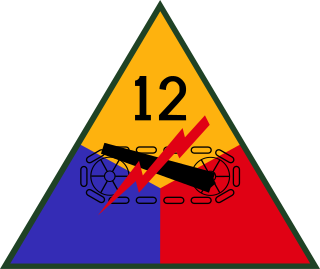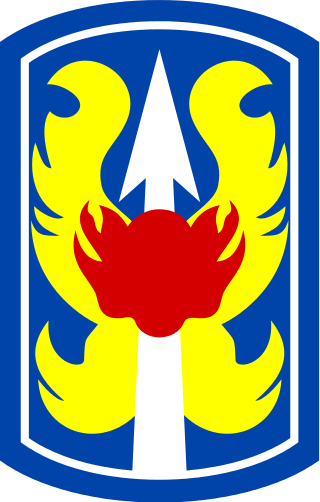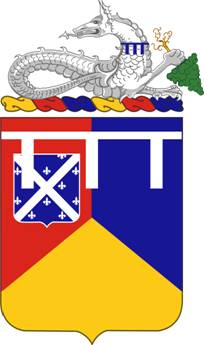
The 1st Infantry Division (1ID) is a combined arms division of the United States Army, and is the oldest continuously serving division in the Regular Army. It has seen continuous service since its organization in 1917 during World War I. It was officially nicknamed "The Big Red One" after its shoulder patch and is also nicknamed "The Fighting First". The division has also received troop monikers of "The Big Dead One" and "The Bloody First" as puns on the respective officially sanctioned nicknames. It is currently based at Fort Riley, Kansas.

The 4th Infantry Division is a division of the United States Army based at Fort Carson, Colorado. It is composed of a division headquarters battalion, three brigade combat teams, a combat aviation brigade, a division sustainment brigade, and a division artillery.

The 12th Armored Division was an armored division of the United States Army in World War II. It fought in the European Theater of Operations in France, Germany and Austria, between November 1944 and May 1945.

The 14th Armored Division was an armored division of the United States Army assigned to the Seventh Army of the Sixth Army Group during World War II. It remains on the permanent roll of the Regular Army as an inactive division, and is eligible for reactivation. The division is officially nicknamed the "Liberators".

The siege of Bastogne was an engagement in December 1944 between American and German forces at the Belgian town of Bastogne, as part of the larger Battle of the Bulge. The goal of the German offensive was the harbor at Antwerp. In order to reach it before the Allies could regroup and bring their superior air power to bear, German mechanized forces had to seize the roadways through eastern Belgium. Because all seven main roads in the densely wooded Ardennes highlands converged on Bastogne, just a few miles away from the border with neighboring Luxembourg, control of its crossroads was vital to the German attack.

The 92nd Infantry Division was an African American, later mixed, infantry division of the United States Army that served in World War I, World War II, and the Korean War. The military was racially segregated during the World Wars. The division was organized in October 1917, after the U.S. entry into World War I, at Camp Funston, Kansas, with African American soldiers from all states. In 1918, before leaving for France, the American buffalo was selected as the divisional insignia due to the "Buffalo Soldiers" nickname, given to African American cavalrymen in the 19th century. The divisional nickname, "Buffalo Soldiers Division", was inherited from the 366th Infantry, one of the first units organized in the division.

The United States Cavalry, or U.S. Cavalry, was the designation of the mounted force of the United States Army. The United States Cavalry was formally created by an act of Congress on 3 August 1861 and ceased as a distinct Army branch in 1942. The name "cavalry" continues to be used as a designation for various specific United States Army formations and functions.

The 761st Tank Battalion was an independent tank battalion of the United States Army during World War II. Its ranks primarily consisted of African American soldiers, who by War Department policy were not permitted to serve in the same units as White troops; the United States Armed Forces did not officially desegregate until after World War II. The 761st were known as the Black Panthers after their distinctive unit insignia, which featured a black panther's head, and the unit's motto was "Come out fighting". Decades after the war, the unit received a Presidential Unit Citation for its actions. In addition, a large number of individual members also received medals, including one Medal of Honor, eleven Silver Stars and approximately 300 Purple Hearts.

The 199th Infantry Brigade (Light) is a unit of the United States Army which served in the Army Reserve from 1921 to 1940, in the active army from 1966 to 1970 (serving in the Vietnam War), briefly in 1991–1992 at Fort Lewis, and from 2007 as an active army training formation at Fort Moore.

The 66th Armor Regiment is the oldest armored unit in the United States Army, tracing its lineage to the 301st Tank Battalion which served with distinction soon after it was formed in the First World War; the 301st trained at Camp Meade, Maryland, where then-Cpt. Dwight D. Eisenhower was an instructor. It has often been rumored that the 301st, the parent unit of the 66th, was first commanded by Col. George S. Patton, but this appears not to have been the case; while Patton was the first officer assigned to the Tank Corps, and while the 301st Tank Battalion was the first unit formed, Patton went nearly immediately to France to train Americans attached to Allied commands. The 301st was the only American heavy tank battalion to have seen action in the war. After the war, the 301st transitioned in the Regular Army to become the 66th Infantry Regiment by way of the 16th Tank Battalion.

The Army Ground Forces were one of the three autonomous components of the Army of the United States during World War II, the others being the Army Air Forces and Army Service Forces. Throughout their existence, Army Ground Forces were the largest training organization ever established in the United States. Its strength of 780,000 troops on 1 May 1942 grew to a peak of 2,200,000 by 1 July 1943. Thereafter its strength declined as units departed for overseas theaters.
A combat command was a combined-arms military organization of comparable size to a brigade or regiment employed by armored forces of the United States Army from 1942 until 1963. The structure of combat commands was task-organized and so the forces assigned to a combat command often varied from mission to mission.

The tank destroyer battalion was a type of military unit used by the United States Army during World War II. The unit was organized in one of two different forms—a towed battalion equipped with anti-tank guns, or a mechanized battalion equipped with armored self-propelled guns. The tank destroyer units were formed in response to the German use of massed formations of armored vehicles units early in WWII. The tank destroyer concept envisioned the battalions acting as independent units that would respond at high speed to large enemy tank attacks. In this role, they would be attached in groups or brigades to corps or armies. In practice, they were usually individually attached to infantry divisions. Over one hundred battalions were formed, of which more than half saw combat service. The force was disbanded shortly after the end of the war when the concept had been shown to be militarily unsound.
The 614th Tank Destroyer Battalion was a tank destroyer battalion of the United States Army active during the Second World War. The unit was activated in 1942 and trained through the late summer of 1944. Arriving on the Normandy coast in October, they moved to the Metz, France, area, seeing their first action in late November. In early December, they were attached to the 103rd Infantry Division, a pairing that was to last through the end of combat in Europe. The 3rd Platoon, Company C, of the 614th was the first African-American unit to receive a Distinguished Unit Citation during World War II. They received credit for the Northern France, Rhineland, Ardennes-Alsace and Central Europe campaigns.
The 773rd Tank Destroyer Battalion was a tank destroyer battalion of the United States Army active during the Second World War.

The 27th Armored Division was a United States Army formation. It was part of the New York Army National Guard in the 1950s and 1960s.

An Armored group was a command and control headquarters in the United States Army equivalent to the headquarters of an armored division combat command during World War II. Most armored groups served in the European Theater of Operations (ETO). Typically an armored group was attached to each American corps in the European Theater of Operations.

Separate tank battalions were military formations used by the United States Army during World War II, especially in the European Theater of Operations. These battalions were temporarily attached to infantry, armored, or airborne divisions according to need, though at least one battalion spent the entire war in Europe attached to one division. They were also known as general headquarters ("GHQ") tank battalions.

The 7th Tank Battalion "M.O. Di Dio" is an active tank battalion of the Italian Army, which is based in Pordenone in Friuli-Venezia Giulia and operationally assigned to the 132nd Armored Brigade "Ariete". The unit's lineage traces back to the World War II VII Tank Battalion M13/40, which was formed on 30 January 1941 by the depot of the 32nd Tank Infantry Regiment. The battalion was sent to Libya, where it fought, initially with the 32nd Tank Infantry Regiment and then the 132nd Tank Infantry Regiment, in the Western Desert campaign. The battalion was disbanded on 8 January 1942, due to the losses it had suffered in the British Operation Crusader. In 1959 the battalion was reformed and assigned to the 132nd Tank Regiment. In 1963 it was transferred to the 8th Bersaglieri Regiment. In 1975 the battalion was renamed 7th Tank Battalion "M.O. Di Dio" and assigned to the 8th Mechanized Brigade "Garibaldi". In 1991, the battalion was disbanded. On 1 October 2022, the flag and traditions of the battalion were assigned to the Command and Tactical Supports Unit "Ariete" of the 132nd Armored Brigade "Ariete".
The 679th Tank Destroyer Battalion was a tank destroyer battalion of the United States Army active during the Second World War. The unit was activated in June 1943 and shipped overseas in January 1945. After arrival in France, the unit was sent to the Mediterranean front. After arrival, the unit was attached to the 92nd Infantry Division. Like the 614th Tank Destroyer Battalion, it was one of the three segregated tank destroyer battalions that participated in combat during the Second World War.

















